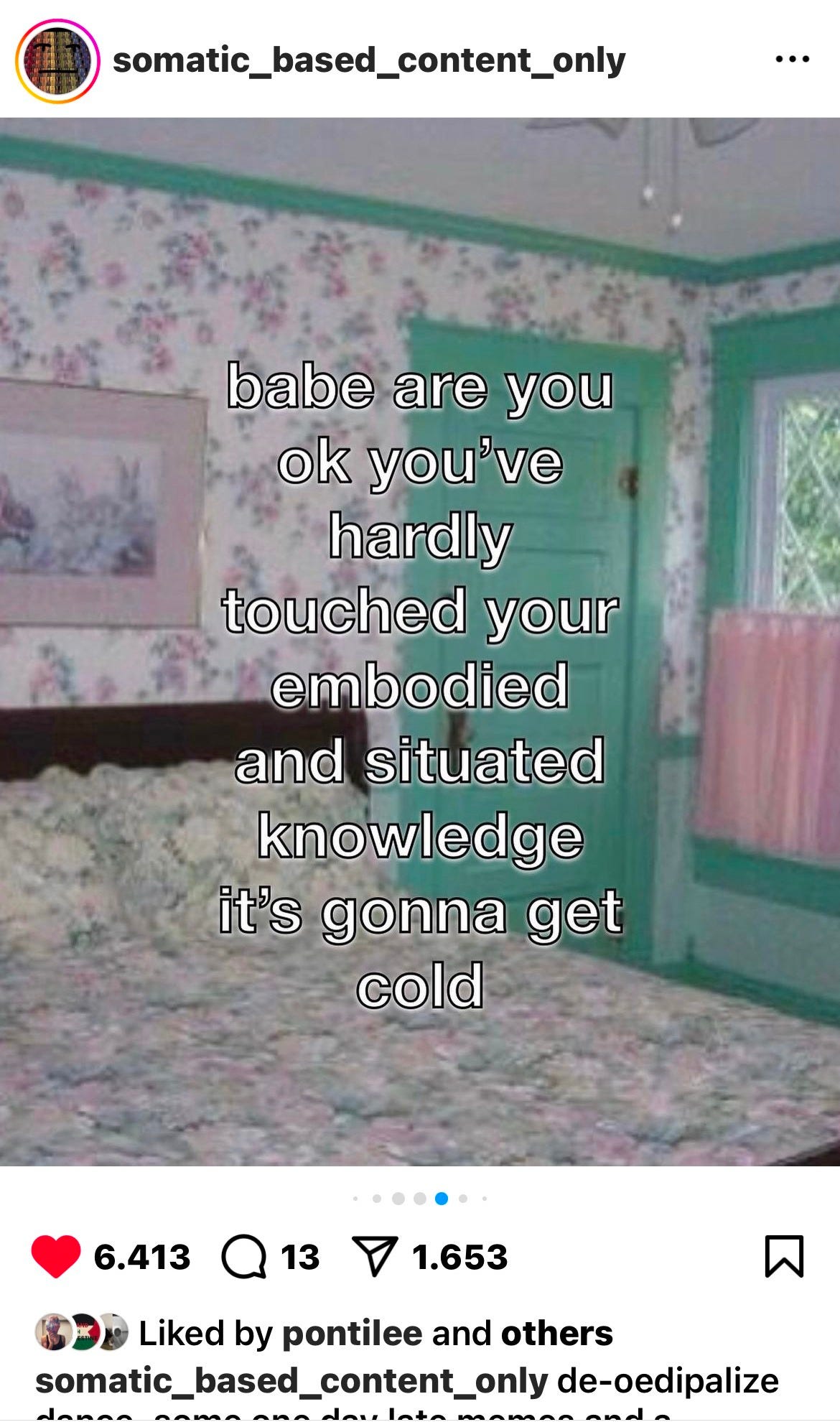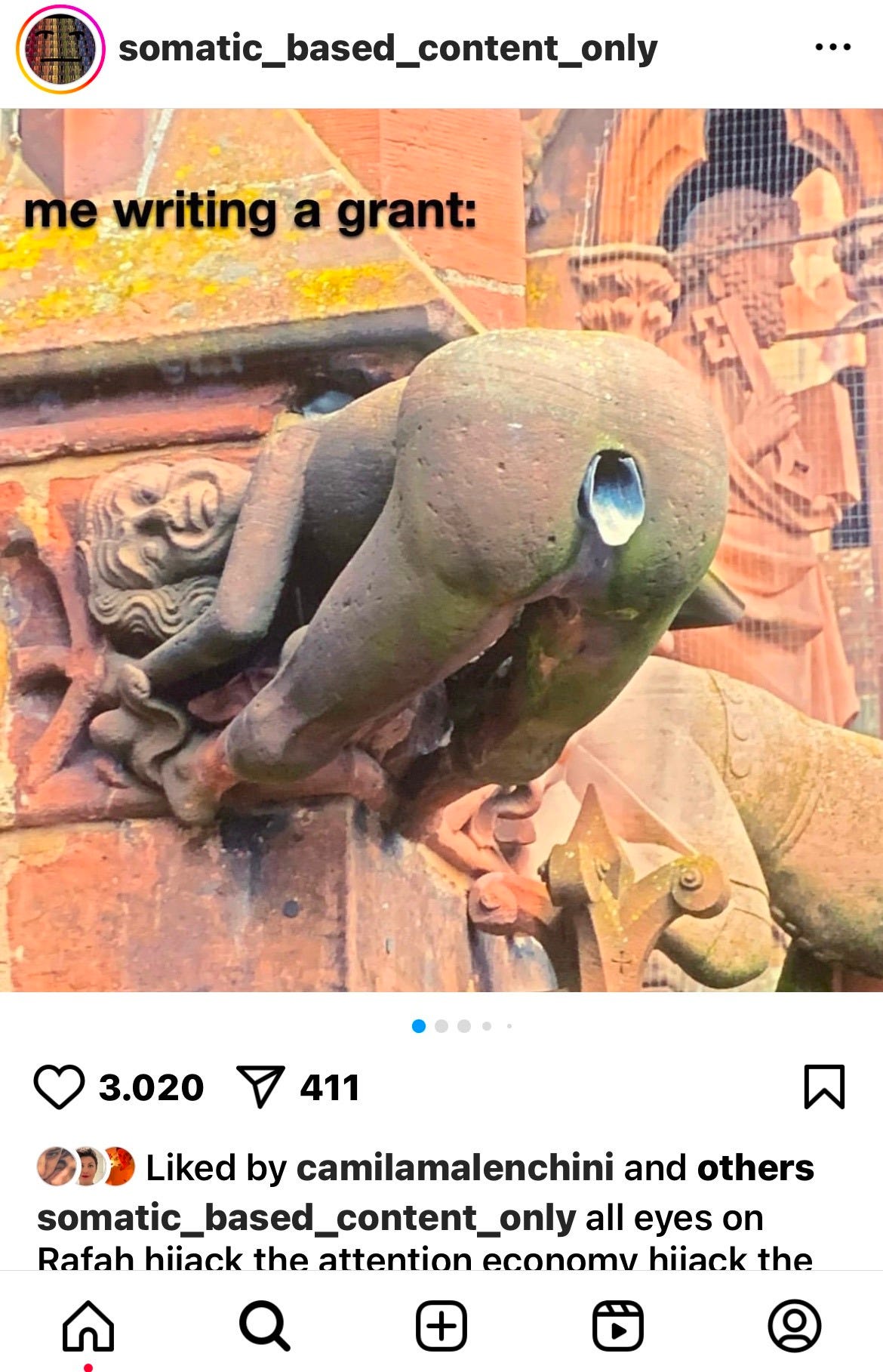Hi everyone,
This month I write from seat 35C, en route to New York. I’ve just finished watching Madame Web, a new Marvel movie about a clairvoyant paramedic and her spawn of beautiful spider-teens. When I watch generic Hollywood movies like this one, especially when viewed in the liminal space of intercontinental air travel, I’m great at crying when I am supposed to. I love bad superhero movies, and this one is “the Cats: The Movie of superhero movies” according to someone named David Fear who writes like an asshole, echoing internet trolls who take the mis/use of the Marvelverse very seriously.
At the cusp of the film’s climax, Madame Web, whose plebian name is Cassie, sees her scientist mother, who died in childbirth, in a vision she has after getting shoved into a magical cave pool deep in Peru. She had assumed her mother didn’t love her – what mother doggedly carries out field research on a rare Peruvian spider’s venom well into her final term?
In her vision, a doctor informs Cassie’s mother that the baby has an untreatable degenerative muscular disease that will cut its life expectancy down to a year, at best. The doctor offers her tissues, in case she needs to cry. Cassie’s mother asks about an experimental treatment she has been researching, using the peptides in the spider venom, and wants to test it. She says she needs to go to Peru to find the cure for her baby. When the doctor advises against travel so late in the pregnancy, she says no. “I refuse to accept the diagnosis of hopelessness, or tissues, and I will teach my daughter to do the same.” In the vision, Cassie responds, “you did,” and they embrace.
As I wept through this posthumous mother-daughter moment of reconciliation and repair, I recalled how this mother had scoffed at the indigenous myths around those who have imbibed the venom: Las Arañas. These spider-people have super-human strength and speed, and crawl on walls and ceilings like a spider. In a condescending, stressed out, white lady kind of way, she spits that she believes in science, not myth. When she finally finds the spider, her guide fatally shoots her and steals the spider, giving himself superhuman properties and becoming the bad guy of the film (he is also, in my opinion, getting set up to be Cassie’s father).
Where am I going with all this? As usual with this letter, I am never sure until I’m done writing.
Last night, I was telling my partner about a practical dance PhD program in Stockholm that a friend was interested in applying to. Wait, it’s practical? The record scratched, for them. A PhD… in dance? And at the end there is no final thesis, but a dance performance? Does that mean they become a Doctor of Dance, at the end? It was starting to seem somewhat amusing, to them. I, on the other hand, was not amused. But I didn’t know which part of this I wanted to defend.
Quick caveat to say that I am not familiar with the details of the dance PhD, other than that it is paid, and that although it is practice-based, as opposed to theoretical, you are required to document your research practice in some way. I think highly of the artists I know who have gone there, like Eleanor Bauer and Anne Juren. It also feels relevant to remind you that I am entering the second year of my master’s in “Live Art Forms” at a German art academy. While I am very happy that my art practice is deemed “serious” enough to get a degree, the absurdity of becoming a master of live arts is not lost on me. Accreditation and examination, for example, are extremely weird. Through me, my partner is learning about the idiosyncrasies of the arts in academia, and how dependent the arts are and always have been on the money that comes when you are legitimized by a larger power structure.
Art needs enough contextualizing to make it clear that it is worthy of entertaining the ruling class. Indeed, it is a matter of material survival that professional artists gain legitimacy and attention in various arenas, academia being a big one. Religious affiliation is an old one. Science (as in STEM, not the humanities) is a newer one. Weird incongruencies do often occur thanks to this dynamic. It’s so weird to be devoted to a craft that doesn’t have a clear use-value, and that is this existentially insecure and power-dependent. I guess this is why I was not amused, and also why I didn’t know what or how to defend art.
In all fairness, it is ridiculous to cram such an uncontainable, immeasurable, and ephemeral thing as dance into the format of a PhD. It’s like cramming something as mysterious and leaky as the body into medicine – it hardly makes sense, except that medicine has use-value. No lives will be saved by categorizing dance scores into unit of measure, the way categorizing blood types has proven to be very, very useful. A part of me does find it ridiculous that so much time and resources are spent thinking about dance as translation, dancing as listening, dance and writing. There is a lot of value ascribed to the ability of dance to open up questions, which is great, but no expectation that dance will be able to answer them.
It’s not like I don’t love questions. I live by an ethics that doesn’t rely on facts or answers, rather one that surfs on questions, poetics, and subjective interpretation. This is why I love dance, I guess. For how hospitable it is as a mode of meaning-making, and how generative it can be to perform critical analysis of how the meaning was made. I recommend geeking out on the translator’s note in a novel called Nora the Many, one of the written elements of Eleanor Bauer’s doctoral research at Stockholm University of the Arts. Dance is relevant for exactly the questions it asks about authorship, time, games, rules, grace, sharing space with others, and the tumultuous experience of cramming our leaky mysterious bodies into structures of human design.
Cassie’s arachnologist mother wouldn’t understand the idea of a dance PhD, because she was researching peptides in poisonous spider venom, not the writing of space/time with the body in motion. The former ended up curing her child’s disease, which led Cassie to fulfill a prophecy and eliminate the bad guy (again, my bet is he is the father and that he survives being crushed) and the latter NEVER WOULD HAVE SAVED CASSIE.
But the whole reason the Mom pursued her research in Peruvian spider peptides was because she was dissatisfied with the boundaries of science. It was too tight a frame, and all it offered her was tissues and death. To complicate things further, when Cassie eventually learns to use her powers and becomes Madame Web, and gains the ability to be in multiple places at once – she taps into the intricate magical web that connects us all, which makes her body divide and multiply
At the end, when Madame Web is recovering in a hospital bed, a nurse comes in and asks the soon-to-be-spidergirls if any of them are next of kin. None have parents to take care of them, each for different reasons. One’s father got deported, the other one’s mother is in a psych ward while her father has a new family he would rather she not be a part of, and the third one’s parents are too rich and busy to care. “They’re all mine,” says Madame Cassie Web, somewhat ominously, but also in a way that rings the bell of finding chosen family in this cruel, cruel world. Through the hospital scene that establishes this bond, embellished by the manipulative music of Hollywood cinema, my fragile leaky body sailing in a metal container far above the ocean, I shook with tears.
Big hugs from somewhere in the air ~
Louise
It has been one year since it has been possible to pay for 5, 6, 7, 8 – a letter of dance and devotion. Thank you so much to my eleven subscribers! One of the first people to upgrade has let me know that Substack auto-renews your yearly subscription. So, I wanted to give those of you who subscribed later a head’s up about that, in case your financial situation has changed.
Financial contributions are so meaningful to me and I love to be compensated for the time I put into these letters (it’s more than just a plane ride, but it sounded cool), but if your upgrade isn’t working for you any more for any reason, I totally get it.
I want to thank you all of you for supporting me and this writing. There are many ways to support 5, 6, 7, 8, reading it being the first way, and telling me what you think about it being the second. Sharing, posting about it, recommending it are also great ways. The financial contributions are there to make sure that this letter can continue to be freely accessible for everyone, for as long as this show is on the road.
Thank you to Soph Kahlau, Anne Swardson, Henry Trueheart, and Ashley Guzman for guest editing this edition of 5, 6, 7, 8!









This is a reassuring read as someone hoping to start a dance phd soon :) The body is the most clunky, impractical research method, but in ways, the only one that really matters.